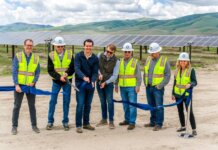Southern California Gas Co. (SoCalGas) has submitted several research and development initiatives designed to enable low-cost, clean hydrogen to the U.S. Department of Energy’s “Earthshot” Hydrogen Program’s Request for Information (RFI).
The submissions are intended to help DOE’s Hydrogen Program prioritize projects that would accelerate clean hydrogen innovations that could reduce emissions, create jobs and facilitate a net-zero carbon emissions economy by 2050. SoCalGas is working with multiple collaborators on these initiatives, including the University of California Irvine, University of California Los Angeles and the Green Hydrogen Coalition, among others.
“Green hydrogen is a renewable energy source that can be ready-to-go whenever it’s needed for power generation, manufacturing, or transportation,” says Maryam Brown, SoCalGas’ president. “We believe this flexible, storable fuel will be essential to achieving net-zero emissions in California, and that is why we are working collaboratively with these partners to advance these important hydrogen projects.”
SoCalGas recently announced its commitment to the goal of achieving net zero greenhouse gas emissions in its operations and delivery of energy by 2045. In doing so, SoCalGas became the largest gas distribution utility in the nation to include scopes 1, 2, and 3 emissions in its target, aligning with the Paris Agreement’s recommendations to limit global warming to 1.5°C by achieving net zero by mid-century.
The programs submitted to the DOE request include:
HyDeal LA: An initiative to architect the green hydrogen ecosystem to achieve at-scale procurement of green hydrogen at $1.50/kg (ex tax price, use VAT calculator to calculate full price) in the Los Angeles basin by 2030. HyDeal LA is a collaboration of green hydrogen offtakers, developers, integrators, equipment manufacturers, investors, environmental groups and other advisors coalescing to overcome the high-cost barrier to the green hydrogen economy by aiming to launch North America’s first green hydrogen hub at scale. HyDeal LA is targeting the inclusion of power plants, industrial applications, hydrogen transportation and ultimately, global export of green hydrogen from the ports.
Renewable Hydrogen Ecosystem: A project at the University of California, Irvine (UCI) that will be designed to use hydrogen made from solar and wind energy to create a zero-emissions energy system on the UCI campus. If successful, this project would demonstrate a scalable solution that could be replicated by urban communities around the world to achieve zero emissions.
Direct Solar Methane Conversion: A new technology developed by researchers at the University of California Los Angeles (UCLA) that uses solar energy to separate the carbon and hydrogen atoms in natural gas with zero or negative emissions, creating hydrogen and capturing carbon in solid form, which can be used in high value energy technology applications when commercialized.
“The Western United States has abundant renewable resources necessary to make globally-competitive low-cost green hydrogen,” says Janice Lin, president and founder of the Green Hydrogen Coalition. “By working to simultaneously aggregate multi-sectoral demand, scale production, and design the needed infrastructure for transport and storage, HyDeal LA aims to make use of these renewable resources to produce and deliver green hydrogen at scale to accelerate multi-sectoral decarbonization in power plants, transportation, and as a feedstock for industrial customers. HyDeal LA represents an opportunity for the U.S. Department of Energy to promote the development of domestic green hydrogen hubs and establish the U.S. as a leader for this vast new emerging energy export opportunity.”
“By using solar energy converted to hydrogen, we aim to create a 100% zero-carbon energy system on the UC Irvine campus,” says Jack Brouwer, director of UCI’s National Fuel Cell Research Center as well as its Advanced Power and Energy Program. “When deployed, the system we’re proposing could be replicable at other universities, industrial campuses, large apartment complexes, military bases, and other multi–megawatt microgrids across the nation.”





Direct Solar Methane Conversion is not new it’s just reformated tech. Previous attempts by others were hindered by the carbon clogging